
|
Now it is 6.2 mag (Dec. 18, Carlos Labordena). It was expected to brighten up to 4-5 mag from autumn to winter. However, the brightness evolution has stopped in September. In the Northern Hemisphere, it is appearing in the morning sky. It will be observable in excellent condition after this. In the Southern Hemisphere, it is hardly observable after this.
Date(TT) R.A. (2000) Decl. Delta r Elong. m1 Best Time(A, h)
Dec. 19 14 17.26 1 42.2 1.168 1.029 56 5.7 2:54 (265, 4)
Dec. 26 14 16.09 9 31.5 1.018 1.108 67 5.6 2:57 (254, 6)
|

|
It brightened very rapidly. Now it is so bright as 8.6 mag (Dec. 16, Neil Norman). It is observable at 9-10 mag until spring in excellent condition in the Northern Hemisphere. It keeps unobservable in the Southern Hemisphere.
Date(TT) R.A. (2000) Decl. Delta r Elong. m1 Best Time(A, h)
Dec. 19 16 52.10 62 27.0 1.920 2.103 86 9.3 2:54 (214,-45)
Dec. 26 16 54.79 62 1.4 1.919 2.109 86 9.4 2:57 (215,-42)
|
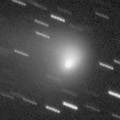
|
Now it is so bright as 9.9 mag (Dec. 17, Marco Goiato). It will pass close to the earth from spring to summer, and it is expected to be observable at 6-7 mag in good condition. It is observable in excellent condition in the Northern Hemispehre. It locates very low in the Southern Hemisphere.
Date(TT) R.A. (2000) Decl. Delta r Elong. m1 Best Time(A, h)
Dec. 19 0 34.32 28 31.4 1.635 2.192 111 10.0 20:58 (149, 19)
Dec. 26 0 17.42 24 42.7 1.717 2.120 99 9.9 21:02 (137, 16)
|

|
First return of a periodic comet which brightened up to 8 mag in major outburst in 2010. It will be observable in excellent condition from winter to spring. Now it is not detected, fainter than 20 mag (Dec. 9, Jean-Francois Soulier).
Date(TT) R.A. (2000) Decl. Delta r Elong. m1 Best Time(A, h)
Dec. 19 9 33.14 32 13.2 0.955 1.752 129 12.1 2:54 (192, 22)
Dec. 26 9 40.17 32 24.1 0.887 1.725 134 11.6 2:57 (186, 22)
|
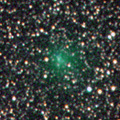
|
It brightened very rapidly. Now it is bright as 9.2 mag (Nov. 30, Juan Jose Gonzalez). It keeps 11-13 mag until February. But it keeps very low.
Date(TT) R.A. (2000) Decl. Delta r Elong. m1 Best Time(A, h)
Dec. 19 20 55.03 -23 13.4 2.013 1.464 43 11.7 20:58 ( 72, 15)
Dec. 26 21 19.48 -21 59.9 2.058 1.484 42 11.9 21:02 ( 72, 12)
|
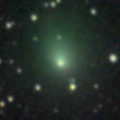
|
Now it is bright as 9.7 mag (Nov. 30, Juan Jose Gonzalez). It is observable in the evening low sky until early December in the Southern Hemisphere, or until late December in the Northern Hemisphere.
Date(TT) R.A. (2000) Decl. Delta r Elong. m1 Best Time(A, h)
Dec. 19 20 3.48 -21 20.1 2.403 1.654 32 11.8 20:58 ( 66, 4)
Dec. 26 20 25.24 -20 23.7 2.455 1.678 30 12.0 21:02 ( 66, 1)
|
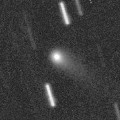
|
Now it is bright as 11.9 mag (Dec. 8, Carlos Labordena). It keeps 12 mag for a long time from 2015 autumn to 2016 summer. In the Northern Hemispehre, it keeps observable in good condition for a long time. It keeps unobservable in the Southern Hemisphere.
Date(TT) R.A. (2000) Decl. Delta r Elong. m1 Best Time(A, h)
Dec. 19 18 48.29 77 23.5 2.444 2.807 101 12.2 20:58 (165,-41)
Dec. 26 19 10.87 74 47.6 2.463 2.785 98 12.2 21:02 (162,-42)
|
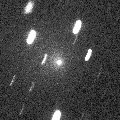
|
New bright comet. Now it is 12.8 mag (Dec. 19, Michael Jager). It looks diffuse visually. It is observable in excellent condition in the Northern Hemisphere. It keeps 13 mag within December, but it will be fading rapidly after January. It is not observable in the Southern Hemisphere.
Date(TT) R.A. (2000) Decl. Delta r Elong. m1 Best Time(A, h)
Dec. 19 12 21.74 39 18.1 0.968 1.472 97 12.8 2:54 (220, 0)
Dec. 26 11 56.80 52 4.7 0.874 1.533 111 12.8 2:57 (204, -4)
|
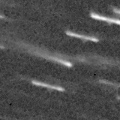
|
Appearing in the evening sky. Now it is bright as 12.0-12.5 mag (Dec. 8, Michael Jager). It tends to brighten very rapidly around the perihelion passage. It will fade out very rapidly after this.
Date(TT) R.A. (2000) Decl. Delta r Elong. m1 Best Time(A, h)
Dec. 19 20 29.00 -14 50.3 1.040 0.687 39 13.0 20:58 ( 76, 5)
Dec. 26 21 23.43 -11 23.8 1.022 0.786 46 13.9 21:02 ( 82, 8)
|

|
It brightened up to 3.7 mag and became a naked eye comet in mid January in 2015 (Jan. 13, Marek Biely). Now it is fading. But it is bright as 11.9 mag still now (Nov. 25, Thomas Lehmann). In the Northern Hemisphere, it keeps observable for a long time until the comet fades out, although it becomes low temporarily in December. It is not observable until March in the Southern Hemisphere.
Date(TT) R.A. (2000) Decl. Delta r Elong. m1 Best Time(A, h)
Dec. 19 17 38.76 20 41.4 4.904 4.253 44 13.1 2:54 (277,-47)
Dec. 26 17 45.20 20 21.3 4.970 4.322 44 13.2 2:57 (274,-42)
|

|
Now it is 12.5 mag (Nov. 20, Seiichi Yoshida). It will be fading slowly after this. In the Northern Hemisphere, it keeps observable in good condition. It will be getting higher gradually after this also in the Southern Hemisphere.
Date(TT) R.A. (2000) Decl. Delta r Elong. m1 Best Time(A, h)
Dec. 19 12 7.10 7 56.1 1.682 1.920 88 13.6 2:54 (239, 25)
Dec. 26 12 13.53 7 35.1 1.652 1.974 93 13.7 2:57 (234, 30)
|
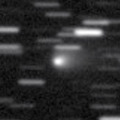
|
Now it is 15.2 mag (Dec. 7, Jean-Francois Soulier). It will brighten up to 11 mag from spring to summer. In the Northern Hemisphere, it keeps observable in good condition while the comet will be brightening. It locates somewhat low in the Southern Hemisphere.
Date(TT) R.A. (2000) Decl. Delta r Elong. m1 Best Time(A, h)
Dec. 19 5 37.16 19 12.5 1.528 2.510 175 14.0 23:45 (180, 36)
Dec. 26 5 29.50 19 12.8 1.497 2.468 168 13.9 23:10 (180, 36)
|

|
Now it is 14.9 mag (Nov. 13, Hidetaka Sato). It will brighten up to 13 mag from winter to spring. It will be observable in excellent condition in the Southern Hemisphere. But it locates somewhat low in the Northern Hemisphere.
Date(TT) R.A. (2000) Decl. Delta r Elong. m1 Best Time(A, h)
Dec. 19 13 46.54 -10 8.0 2.547 2.193 58 14.1 2:54 (271, 17)
Dec. 26 13 59.39 -11 26.1 2.475 2.190 61 14.0 2:57 (269, 22)
|

|
It is not observable now. It will appear in the morning sky in February.
Date(TT) R.A. (2000) Decl. Delta r Elong. m1 Best Time(A, h)
Dec. 19 18 26.47 -27 57.8 6.945 5.980 10 14.0 20:58 ( 47, -9)
Dec. 26 18 32.80 -27 49.7 6.955 5.978 5 14.0 21:02 ( 43,-12)
|

|
Now it is 14.8 mag (Nov. 22, Catalina Sky Survey). Distant object, but it keeps observable at 14-15 mag for a long time from 2015 to 2016.
Date(TT) R.A. (2000) Decl. Delta r Elong. m1 Best Time(A, h)
Dec. 19 21 43.85 -7 42.1 5.451 5.019 59 14.7 20:58 ( 92, 16)
Dec. 26 21 49.65 -7 32.3 5.529 5.008 53 14.7 21:02 ( 88, 10)
|
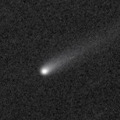
|
It brightened very rapidly in 2015 spring, and reached up to 13.8 mag (May 11, Sandor Szabo). It is bright as 15.5 mag still now (Dec. 20, Jean-Francois Soulier). It keeps 15-16 mag for a while until spring. It is observable in excellent condition in the Southern Hemisphere. But it locates somewhat low in the Northern Hemisphere.
Date(TT) R.A. (2000) Decl. Delta r Elong. m1 Best Time(A, h)
Dec. 19 13 33.26 -21 47.0 4.123 3.690 57 15.4 2:54 (279, 26)
Dec. 26 13 40.26 -22 44.1 4.056 3.710 62 15.4 2:57 (277, 31)
|

|
First return of a periodic comet discovered in 2003. Now it is 15.5 mag (Nov. 15, Yuji Ohshima). It is brightening very rapidly. It will approach to the earth from autumn to winter, and it will brighten up to 15 mag and observable in excellent condition.
Date(TT) R.A. (2000) Decl. Delta r Elong. m1 Best Time(A, h)
Dec. 19 4 39.71 13 45.3 0.703 1.666 161 15.4 22:48 (180, 41)
Dec. 26 4 36.62 17 24.0 0.728 1.675 156 15.4 22:18 (180, 37)
|
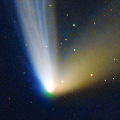
|
It approached to the sun down to 0.3 a.u. on July 6, and brighted up to 3.9 mag (July 6, Thomas Lehmann). Now it is fading. It has already faded down to 12.9 mag (Oct. 3, Chris Wyatt). In the Northern Hemisphere, it keeps observable until the comet fades out. It will not be observable after this in the Northern Hemisphere.
Date(TT) R.A. (2000) Decl. Delta r Elong. m1 Best Time(A, h)
Dec. 19 17 47.44 -56 0.3 3.814 3.032 32 15.4 20:58 ( 24, 9)
Dec. 26 18 3.72 -56 19.9 3.902 3.124 33 15.6 2:57 (336, 10)
|

|
Now it is 13.6 mag (Nov. 12, Sandor Szabo). In the Northern Hemisphere, it keeps observable after this while the comet will be fading. It is not observable in the Southern Hemisphere until January when the comet will fade down to 16 mag.
Date(TT) R.A. (2000) Decl. Delta r Elong. m1 Best Time(A, h)
Dec. 19 13 45.58 20 13.4 2.606 2.498 72 15.4 2:54 (246, -1)
Dec. 26 13 54.06 20 20.5 2.576 2.548 77 15.5 2:57 (242, 4)
|

|
Now it is 15.7 mag (Nov. 11, Sandor Szabo). It keeps 15-16 mag for a long time until 2016. It keeps observable in excellent condition in the Northern Hemisphere. It keeps unobservable in the Southern Hemisphere.
Date(TT) R.A. (2000) Decl. Delta r Elong. m1 Best Time(A, h)
Dec. 19 3 49.00 74 45.8 4.569 5.214 126 15.5 21:58 (180,-20)
Dec. 26 3 31.82 74 49.4 4.601 5.220 124 15.5 21:13 (180,-20)
|
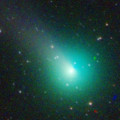
|
It brightened up to 6.0 mag in mid May (May 14, Chris Wyatt). Now it is fading. It has already faded down to 15.6 mag (Nov. 12, Sandor Szabo). In the Northern Hemisphere, it keeps observable in good condition after this while the comet will be fading. It locates somewhat low in the Southern Hemisphere.
Date(TT) R.A. (2000) Decl. Delta r Elong. m1 Best Time(A, h)
Dec. 19 6 34.37 37 29.5 2.324 3.275 162 15.5 0:48 (180, 18)
Dec. 26 6 14.48 38 8.9 2.396 3.357 165 15.7 0:01 (180, 17)
|

|
It brightened up to 8.8 mag in 2015 spring (Apr. 3, Marco Goiato). Now it is fading. It has already faded down to 13.5 mag (Nov. 11, Mike Wolle). It keeps observable until March when the comet becomes fainter than 18 mag.
Date(TT) R.A. (2000) Decl. Delta r Elong. m1 Best Time(A, h)
Dec. 19 1 46.47 9 51.4 2.087 2.735 121 15.5 20:58 (159, 43)
Dec. 26 1 47.83 10 10.0 2.215 2.778 115 15.8 21:02 (150, 40)
|

|
Now it is 14.0 mag and visible visually (Nov. 30, Chris Wyatt). Now it is passing near by the earth, and it is observable at 15 mag in excellent condition in December. It will fade out rapidly after January.
Date(TT) R.A. (2000) Decl. Delta r Elong. m1 Best Time(A, h)
Dec. 19 5 7.54 2 39.9 0.565 1.521 157 15.6 23:16 (180, 52)
Dec. 26 5 6.31 5 59.5 0.587 1.538 155 15.7 22:48 (180, 49)
|
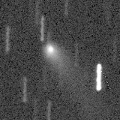
|
Now it is 15.1 mag (Nov. 11, Sandor Szabo). It keeps 15 mag for a long time from 2014 to 2015. It is observable in excellent condition in the Northern Hemisphere. It locates low in the Southern Hemisphere.
Date(TT) R.A. (2000) Decl. Delta r Elong. m1 Best Time(A, h)
Dec. 19 0 30.80 46 8.8 4.077 4.572 114 15.7 20:58 (157, 3)
Dec. 26 0 29.72 45 58.1 4.189 4.603 108 15.7 21:02 (152, 0)
|

|
Now it is 15.4 mag (Nov. 15, Yuji Ohshima). It will be fading slowly after this. In the Northern Hemisphere, it keeps observable for a long time until the comet fades out. In the Southern Hemisphere, it will be unobservable in early January.
Date(TT) R.A. (2000) Decl. Delta r Elong. m1 Best Time(A, h)
Dec. 19 0 14.11 15 8.7 3.948 4.271 102 15.7 20:58 (137, 28)
Dec. 26 0 9.86 15 18.6 4.090 4.283 94 15.8 21:02 (130, 22)
|
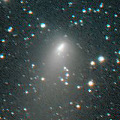
|
It brightened rapidly up to 10.4 mag from July to August (July 18, Maik Meyer). Now it is fading. It has already faded down to 14.2 mag (Nov. 11, Sandor Szabo). It is observable in good condition in the Northern Hemisphere. It is not observable in the Southern Hemisphere.
Date(TT) R.A. (2000) Decl. Delta r Elong. m1 Best Time(A, h)
Dec. 19 21 56.81 46 51.9 2.123 2.344 90 15.8 20:58 (138,-15)
Dec. 26 22 17.25 46 53.7 2.215 2.405 88 16.1 21:02 (137,-16)
|

|
First return of a periodic comet discovered in 1994. It brightened up to 13.8 mag from summer to autumn (Sept. 7, Taras Prystavski). Now it is fading, but it is bright as 15.2 mag still now (Nov. 11, Sandor Szabo). It is observable in excellent condition in the Southern Hemisphere. It locates somewhat low in the Northern Hemisphere.
Date(TT) R.A. (2000) Decl. Delta r Elong. m1 Best Time(A, h)
Dec. 19 23 21.58 -13 10.7 2.486 2.502 79 16.0 20:58 (102, 39)
Dec. 26 23 30.40 -11 18.5 2.581 2.516 75 16.1 21:02 (100, 33)
|
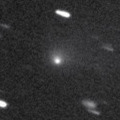
|
Now it is 14.5 mag (Nov. 11, Sandor Szabo). It keeps observable at 15 mag in good condition for a while.
Date(TT) R.A. (2000) Decl. Delta r Elong. m1 Best Time(A, h)
Dec. 19 2 12.90 4 22.2 1.473 2.196 125 16.1 20:58 (166, 50)
Dec. 26 2 16.43 4 58.4 1.554 2.211 119 16.3 21:02 (156, 47)
|

|
It brightened up to 11-12 mag in 2012. It has already faded down to 16.5 mag (July 9, Taras Prystavski). It is observable at 16 mag in good condition from winter to spring.
Date(TT) R.A. (2000) Decl. Delta r Elong. m1 Best Time(A, h)
Dec. 19 11 15.16 -7 14.5 10.528 10.640 93 16.3 2:54 (241, 45)
Dec. 26 11 13.78 -7 16.1 10.444 10.678 101 16.3 2:57 (232, 51)
|
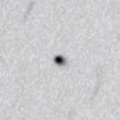
|
Now it is 16.7 mag (Nov. 5, Masayuki Suzuki). It was reported as 15.8 mag visually (Nov. 12, Sandor Szabo). It is expected to brighten up to 7 mag in 2017 summer. In the Northern Hemisphere, it keeps observable in good condition until the highlight while the comet will be brightening. In the Southern Hemisphere, it is not observable until early 2017.
Date(TT) R.A. (2000) Decl. Delta r Elong. m1 Best Time(A, h)
Dec. 19 8 6.35 61 9.9 5.363 6.100 135 16.5 2:19 (180, -6)
Dec. 26 8 0.25 61 56.7 5.278 6.041 137 16.4 1:46 (180, -7)
|

|
Now it is 17.5 mag (Nov. 13, Hidetaka Sato). It will brighten rapidly after this, and it will be observable at 14-15 mag in good condition from winter to summer.
Date(TT) R.A. (2000) Decl. Delta r Elong. m1 Best Time(A, h)
Dec. 19 12 59.61 5 24.5 2.592 2.527 75 16.6 2:54 (250, 17)
Dec. 26 13 7.67 4 10.9 2.489 2.510 79 16.5 2:57 (247, 23)
|
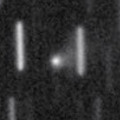
|
Brightening very rapidly, and it keeps brightening even after the perihelion passage. Now it is very bright as 15.5 mag (Nov. 21, Catalina Sky Survey). It keeps observable in excellent condition for a while.
Date(TT) R.A. (2000) Decl. Delta r Elong. m1 Best Time(A, h)
Dec. 19 6 5.06 -15 44.8 1.106 1.968 140 16.5 0:18 (180, 71)
Dec. 26 5 59.66 -16 1.0 1.137 1.996 140 16.7 23:40 (180, 71)
|

|
Now it is 16.9 mag (Nov. 15, J. Bel). It will brighten up to 14 mag in 2016 summer. But it is not observable at the highlight. It keeps observable until March while the comet will be brightening gradually up to 15-16 mag.
Date(TT) R.A. (2000) Decl. Delta r Elong. m1 Best Time(A, h)
Dec. 19 0 24.81 -6 10.0 2.095 2.415 96 16.7 20:58 (123, 46)
Dec. 26 0 30.25 -5 25.4 2.156 2.387 91 16.7 21:02 (117, 41)
|
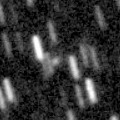
|
Now it is 17.0 mag (Nov. 3, A. Maury, J.-F. Soulier, J.-G. Bosch, T. Noel). It keeps 16.5 mag for a long time in 2016, and it will be observable in excellent condition in the Southern Hemisphere. It is hardly observable in the Northern Hemisphere.
Date(TT) R.A. (2000) Decl. Delta r Elong. m1 Best Time(A, h)
Dec. 19 7 37.70 -61 22.8 3.437 3.612 92 16.8 1:51 ( 0, 64)
Dec. 26 7 11.20 -62 55.3 3.401 3.589 92 16.7 0:57 ( 0, 62)
|
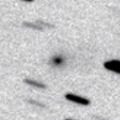
|
Now it is 17.3 mag (Nov. 21, Catalina Sky Survey). It is observable at 16.5 mag in excellent condition from December to February. It locates somewhat low in the Southern Hemisphere.
Date(TT) R.A. (2000) Decl. Delta r Elong. m1 Best Time(A, h)
Dec. 19 8 35.70 18 17.7 1.071 1.931 139 17.0 2:48 (180, 37)
Dec. 26 8 36.41 18 55.8 1.033 1.933 147 16.8 2:21 (180, 36)
|

|
It brightened up to 13 mag in 2014. It is bright as 14.8 mag visually still now (Nov. 11, Sandor Szabo). It will be fading after this, and will be fainter than 18 mag in spring.
Date(TT) R.A. (2000) Decl. Delta r Elong. m1 Best Time(A, h)
Dec. 19 0 55.38 0 16.5 3.705 4.090 106 16.9 20:58 (137, 46)
Dec. 26 0 56.79 0 42.0 3.825 4.106 99 17.0 21:02 (129, 41)
|

|
Now it is 16.5 mag (Dec. 20, Michael Jager). It must have been observable at 16-17 mag in good condition from summer to autumn in the Northern Hemisphere, but it was not discovered. It will be observable after mid January also in the Southern Hemisphere. However, it will be fading after this, and will be fainter than 18 mag in March.
Date(TT) R.A. (2000) Decl. Delta r Elong. m1 Best Time(A, h)
Dec. 19 12 59.40 37 7.9 1.815 2.070 90 17.0 2:54 (226, -4)
Dec. 26 12 59.46 36 26.7 1.786 2.121 95 17.0 2:57 (222, 1)
|
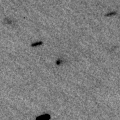
|
Now it is 16.9 mag (Nov. 17, J. Nicolas, C. Rinner, F. Kugel, A. Klotz). It will brighten up to 14 mag in 2017. In 2016, it keeps observable at 16 mag in good condition from winter to spring.
Date(TT) R.A. (2000) Decl. Delta r Elong. m1 Best Time(A, h)
Dec. 19 11 59.60 10 22.4 3.913 4.048 90 17.0 2:54 (236, 25)
Dec. 26 12 2.75 10 18.3 3.792 4.032 97 17.0 2:57 (230, 30)
|
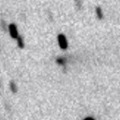
|
Now it is 17.4 mag (Nov. 21, Space Surveillance Telescope, Atom Site). It is observable at 17 mag in good condition in winter.
Date(TT) R.A. (2000) Decl. Delta r Elong. m1 Best Time(A, h)
Dec. 19 8 23.83 15 12.0 1.512 2.365 141 17.1 2:36 (180, 40)
Dec. 26 8 22.09 16 19.9 1.459 2.360 149 17.0 2:07 (180, 39)
|
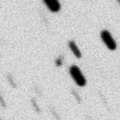
|
Now it is 17.1 mag (Nov. 17, K. Hills). It will brighten up to 16 mag in 2016 summer. In the Southern Hemisphere, it keeps observable in good condition for a long time. In the Northern Hemisphere, it is observable only until next March.
Date(TT) R.A. (2000) Decl. Delta r Elong. m1 Best Time(A, h)
Dec. 19 4 42.57 -20 39.4 2.279 3.040 133 17.1 22:50 (180, 76)
Dec. 26 4 31.03 -22 34.2 2.291 2.993 127 17.1 22:11 (180, 78)
|
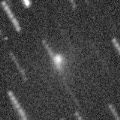
|
Now it is 16.0 mag (Nov. 12, Sandor Szabo). It is observable at 16-17 mag in good condition from October to December in the Northern Hemisphere. It is not observable in the Southern Hemisphere.
Date(TT) R.A. (2000) Decl. Delta r Elong. m1 Best Time(A, h)
Dec. 19 1 16.69 42 9.7 1.680 2.355 122 17.2 20:58 (163, 10)
Dec. 26 1 21.17 37 7.4 1.792 2.398 116 17.4 21:02 (156, 13)
|
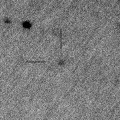
|
Now it is 17.2 mag (Nov. 18, Catalina Sky Survey). Now it is near the aphelion. It is observable at 17 mag in good condition from autumn to winter.
Date(TT) R.A. (2000) Decl. Delta r Elong. m1 Best Time(A, h)
Dec. 19 3 13.03 15 5.9 3.412 4.243 143 17.2 21:22 (180, 40)
Dec. 26 3 10.35 15 5.0 3.475 4.234 135 17.2 21:02 (177, 40)
|

|
It will brighten very rapidly and reach up to 10 mag in March. In this apparition, it keeps observable in excellent condition both brightening and fading period. In the Northern Hemisphere, it will be unobservable temporarily in mid March.
Date(TT) R.A. (2000) Decl. Delta r Elong. m1 Best Time(A, h)
Dec. 19 6 46.12 -4 22.4 0.594 1.522 148 17.7 0:59 (180, 59)
Dec. 26 6 42.09 -6 59.8 0.527 1.460 148 17.3 0:27 (180, 62)
|
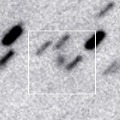
|
Now it is 17.2 mag (Nov. 7, K. Sarneczky). It keeps 17.5 mag for a long time from 2016 to 2019. It keeps locating near by the equator.
Date(TT) R.A. (2000) Decl. Delta r Elong. m1 Best Time(A, h)
Dec. 19 8 13.77 -0 59.1 9.442 10.177 136 17.5 2:26 (180, 56)
Dec. 26 8 12.53 -0 56.5 9.364 10.164 142 17.4 1:57 (180, 56)
|

|
Now it is 19.2 mag (Dec. 8, Jean-Francois Soulier). It will be observable at 11 mag in good condition from spring to summer.
Date(TT) R.A. (2000) Decl. Delta r Elong. m1 Best Time(A, h)
Dec. 19 11 50.88 13 38.2 2.252 2.520 94 17.8 2:54 (231, 24)
Dec. 26 11 58.54 13 25.4 2.125 2.480 99 17.5 2:57 (227, 28)
|
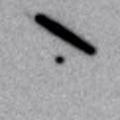
|
Now it is 17.1 mag (Nov. 17, K. Hills). It is observable in good condition in the Northern Hemisphere. It is not observable in the Southern Hemisphere.
Date(TT) R.A. (2000) Decl. Delta r Elong. m1 Best Time(A, h)
Dec. 19 11 34.23 45 15.0 1.584 2.109 108 17.5 2:54 (209, 1)
Dec. 26 11 36.75 46 30.7 1.573 2.160 113 17.5 2:57 (204, 2)
|

|
Now it is 18.3 mag (Nov. 15, Hidetaka Sato). It keeps observable at 17 mag in good condition from winter to spring.
Date(TT) R.A. (2000) Decl. Delta r Elong. m1 Best Time(A, h)
Dec. 19 13 48.17 5 1.9 2.753 2.490 64 17.6 2:54 (258, 8)
Dec. 26 13 59.11 4 21.5 2.679 2.491 68 17.6 2:57 (256, 13)
|
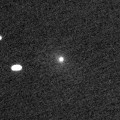
|
Now it is 16.9 mag (Nov. 14, J. Bel). It keeps observable in good condition until the comet fades out. In 2014, it must have been observable at 14 mag in good condition in the Southern Hemisphere.
Date(TT) R.A. (2000) Decl. Delta r Elong. m1 Best Time(A, h)
Dec. 19 23 58.07 4 39.3 4.777 4.959 94 17.6 20:58 (126, 34)
Dec. 26 0 0.06 5 5.7 4.941 5.011 88 17.7 21:02 (120, 28)
|
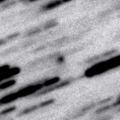
|
Now it is 16.8 mag (Nov. 20, Catalina Sky Survey). It keeps observable in good condition for a while. But it will be fainter than 18 mag in January.
Date(TT) R.A. (2000) Decl. Delta r Elong. m1 Best Time(A, h)
Dec. 19 3 37.79 25 0.4 1.964 2.865 151 17.6 21:47 (180, 30)
Dec. 26 3 34.91 24 30.7 2.045 2.894 143 17.8 21:16 (180, 30)
|

|
It will pass the perihelion in 2019. However, it has not been brightening since the discovery in 2010. Now it is 17.6 mag (Nov. 13, E. Bryssinck). It keeps observable in excellent condition from autumn to next spring in the Northern Hemisphere. It is not observable in the Southern Hemisphere.
Date(TT) R.A. (2000) Decl. Delta r Elong. m1 Best Time(A, h)
Dec. 19 3 17.95 47 46.4 10.013 10.805 142 17.7 21:27 (180, 7)
Dec. 26 3 15.32 47 41.0 10.043 10.781 136 17.7 21:02 (179, 7)
|
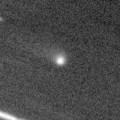
|
It brightened up to 16 mag in early 2015. Now it is fading. It is observable at 18 mag from winter to spring.
Date(TT) R.A. (2000) Decl. Delta r Elong. m1 Best Time(A, h)
Dec. 19 10 36.17 -23 41.9 5.724 5.893 95 17.7 2:54 (253, 63)
Dec. 26 10 31.12 -24 7.3 5.632 5.915 101 17.7 2:57 (243, 70)
|

|
Now it is 17.8 mag (Nov. 18, M. Adamovsky). It will brighten up to 13 mag in 2016 summer. But it is not observable around the highlight. In the Southern Hemisphere, it is observable until February when it brightens up to 17 mag. In the Northern Hemisphere, it is observable until April when it brightens up to 16 mag.
Date(TT) R.A. (2000) Decl. Delta r Elong. m1 Best Time(A, h)
Dec. 19 1 54.87 11 44.5 2.871 3.521 124 17.8 20:58 (162, 41)
Dec. 26 1 53.40 11 22.1 2.895 3.450 116 17.7 21:02 (152, 39)
|

|
It has not been observed yet in this apparition. It tends to be brightest after the perihelion passage. It is observable at 17 mag in excellent condition until March in the Northern Hemisphere. It locates low in the Southern Hemisphere.
Date(TT) R.A. (2000) Decl. Delta r Elong. m1 Best Time(A, h)
Dec. 19 5 5.91 46 8.6 0.908 1.850 155 17.9 23:15 (180, 9)
Dec. 26 5 0.11 45 59.5 0.894 1.825 152 17.8 22:41 (180, 9)
|
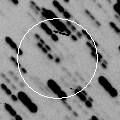
|
New comet. Now it is 17.7 mag (Dec. 8, Yasukazu Ikari). It is observable at 18 mag in good condition until January.
Date(TT) R.A. (2000) Decl. Delta r Elong. m1 Best Time(A, h)
Dec. 19 5 52.97 19 19.5 2.434 3.416 175 17.8 0:06 (180, 36)
Dec. 26 5 48.48 18 18.9 2.447 3.424 171 17.8 23:29 (180, 37)
|
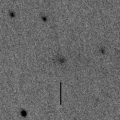
|
Now it is 17.7 mag (Nov. 30, Hidetaka Sato). It was expected to brighten up to 14 mag from winter to summer. But it is much fainter actually. It will be observable in excellent condition in the Southern Hemisphere. It locates low in the Northern Hemisphere.
Date(TT) R.A. (2000) Decl. Delta r Elong. m1 Best Time(A, h)
Dec. 19 13 58.03 -9 44.7 2.672 2.268 55 17.8 2:54 (272, 15)
Dec. 26 14 11.41 -11 33.3 2.599 2.257 59 17.8 2:57 (271, 19)
|

|
It keeps 17-18 mag for a long time since 2013. In the Northern Hemisphere, it is observable at 18 mag in good condition also in this winter. It is not observable in the Southern Hemisphere.
Date(TT) R.A. (2000) Decl. Delta r Elong. m1 Best Time(A, h)
Dec. 19 14 28.49 53 35.2 7.209 7.240 87 17.9 2:54 (221,-26)
Dec. 26 14 29.14 54 14.7 7.167 7.261 91 17.9 2:57 (218,-22)
|
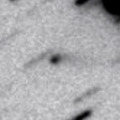
|
New comet. Now it is 17.6 mag (Dec. 17, A. Hidas). It keeps 17-18 mag for a long time until 2017 spring.
Date(TT) R.A. (2000) Decl. Delta r Elong. m1 Best Time(A, h)
Dec. 19 7 6.66 -29 24.6 3.567 4.193 123 18.0 1:19 (180, 84)
Dec. 26 7 2.57 -28 57.5 3.505 4.165 126 17.9 0:48 (180, 84)
|
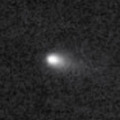
|
It brightened up to 15.9 mag in June as predicted (June 23, Ken-ichi Kadota). It was expected to be observable at 13 mag in good condition from summer to autumn. However, Jean-Gabriel Bosch detected the comet became disintegrating in July. Now it is so faint as 20.1 mag (Oct. 15, Pan-STARRS 1, Haleakala). The fragment D and B are also observed as 18.6 mag (Oct. 31, Catalina Sky Survey) and 20.9 mag (Aug. 21, Pan-STARRS 1, Haleakala) respectively.
Date(TT) R.A. (2000) Decl. Delta r Elong. m1 Best Time(A, h)
Dec. 19 2 4.35 8 17.0 1.353 2.082 125 20.8 20:58 (164, 45)
Dec. 26 2 8.93 9 14.9 1.453 2.118 119 21.1 21:02 (156, 43)
|
|
![]()
 10P/Tempel 2
10P/Tempel 2 22P/Kopff
22P/Kopff C/2014 W2 ( PanSTARRS )
C/2014 W2 ( PanSTARRS ) C/2015 X8 ( NEOWISE )
C/2015 X8 ( NEOWISE ) 249P/LINEAR
249P/LINEAR C/2014 Q2 ( Lovejoy )
C/2014 Q2 ( Lovejoy ) 67P/Churyumov-Gerasimenko
67P/Churyumov-Gerasimenko 81P/Wild 2
81P/Wild 2 116P/Wild 4
116P/Wild 4 29P/Schwassmann-Wachmann 1
29P/Schwassmann-Wachmann 1 C/2011 KP36 ( Spacewatch )
C/2011 KP36 ( Spacewatch ) C/2014 W11 ( PanSTARRS )
C/2014 W11 ( PanSTARRS ) 329P/2015 T1 ( LINEAR-Catalina )
329P/2015 T1 ( LINEAR-Catalina ) C/2014 Q1 ( PanSTARRS )
C/2014 Q1 ( PanSTARRS ) 19P/Borrelly
19P/Borrelly C/2013 V4 ( Catalina )
C/2013 V4 ( Catalina ) C/2015 G2 ( MASTER )
C/2015 G2 ( MASTER ) 88P/Howell
88P/Howell 230P/LINEAR
230P/LINEAR C/2014 N3 ( NEOWISE )
C/2014 N3 ( NEOWISE ) C/2014 A4 ( SONEAR )
C/2014 A4 ( SONEAR ) C/2015 F4 ( Jacques )
C/2015 F4 ( Jacques ) 318P/2014 M6 ( McNaught-Hartley )
318P/2014 M6 ( McNaught-Hartley ) 61P/Shajn-Schaldach
61P/Shajn-Schaldach C/2006 S3 ( LONEOS )
C/2006 S3 ( LONEOS ) C/2015 V2 ( Johnson )
C/2015 V2 ( Johnson ) 77P/Longmore
77P/Longmore P/2015 Q1 ( Scotti )
P/2015 Q1 ( Scotti ) 118P/Shoemaker-Levy 4
118P/Shoemaker-Levy 4 C/2015 B2 ( PanSTARRS )
C/2015 B2 ( PanSTARRS ) 204P/LINEAR-NEAT
204P/LINEAR-NEAT 117P/Helin-Roman-Alu 1
117P/Helin-Roman-Alu 1 C/2015 YG1 ( NEOWISE )
C/2015 YG1 ( NEOWISE ) 65P/Gunn
65P/Gunn 211P/Hill
211P/Hill C/2015 T4 ( PanSTARRS )
C/2015 T4 ( PanSTARRS ) C/2015 GX ( PanSTARRS )
C/2015 GX ( PanSTARRS ) 74P/Smirnova-Chernykh
74P/Smirnova-Chernykh 252P/LINEAR
252P/LINEAR C/2014 B1 ( Schwartz )
C/2014 B1 ( Schwartz ) 9P/Tempel 1
9P/Tempel 1 162P/Siding Spring
162P/Siding Spring 180P/NEAT
180P/NEAT C/2015 K1 ( MASTER )
C/2015 K1 ( MASTER ) 44P/Reinmuth 2
44P/Reinmuth 2 C/2010 U3 ( Boattini )
C/2010 U3 ( Boattini ) C/2013 G9 ( Tenagra )
C/2013 G9 ( Tenagra ) C/2015 TQ209 ( LINEAR )
C/2015 TQ209 ( LINEAR ) 194P/LINEAR
194P/LINEAR C/2015 X4 ( Elenin )
C/2015 X4 ( Elenin ) C/2014 Y1 ( PanSTARRS )
C/2014 Y1 ( PanSTARRS ) C/2012 K8 ( Lemmon )
C/2012 K8 ( Lemmon ) C/2015 X7 ( ATLAS )
C/2015 X7 ( ATLAS ) 51P/Harrington
51P/Harrington![]()



















































